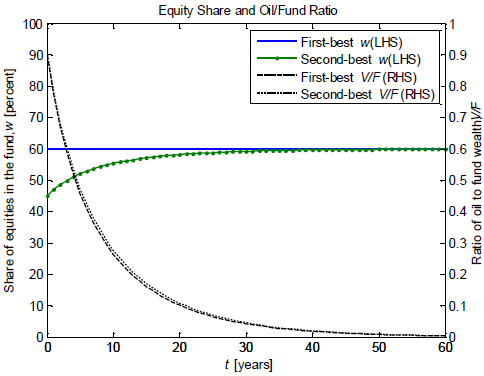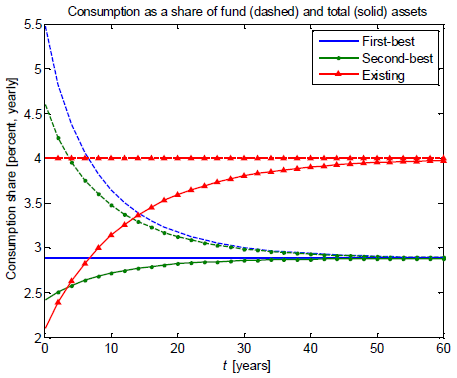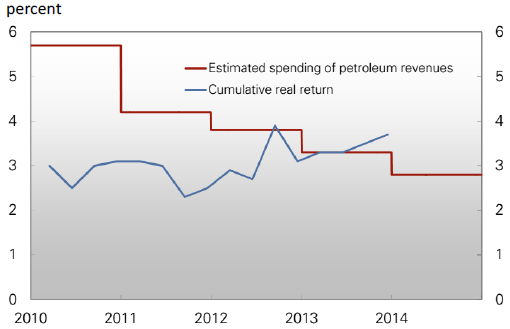Norway Is Right To Reassess Its Sovereign Wealth Fund – Analysis
By VoxEU.org
Norway’s sovereign wealth fund is the largest in the world. As such, it has prompted discussions about its design. This column argues that one flaw in the fund is that it doesn’t consider oil reserves beneath the ground. Changing the equity/bond mix and the spending rule could lead to significant welfare improvements.
By Samuel Wills, Rick van der Ploeg and Ton van den Bremer
Norway’s sovereign wealth fund is large (Ministry of Finance 2013). At $890 billion, it is the largest sovereign wealth fund in existence, holding over 1% of almost every listed stock in the world. However, as the fund approaches $180,000 for every man, woman, and child in Norway, there have been calls to reassess the way it is managed – from divesting oil and gas stocks to reducing the amount spent each year. Recent research provides some support for these calls, by treating above- and below-ground wealth as two sides of the same coin for the first time (van den Bremer et al. 2014).
Current rules for managing the fund
At present, Norway has designed its fund according to the principles of modern portfolio theory. These principles would see Norway construct a highly diversified equity portfolio, choose the size of that portfolio based on its risk preferences, and consume a fixed proportion of the fund’s assets each year (Merton 1971). This is almost exactly what Norway does. Its equity and bond benchmarks are highly diversified indices.1 The size of each depends on Norway’s risk appetite, with the mix changing in 2009 when the country decided to accept more risk for a higher return.2 Finally, Norway has committed explicitly to a rule which states that, on average, 4% of the fund’s balance is spent each year.
However, when the fund was established these principles didn’t give due consideration to oil beneath the ground. In fact, in the 5000 words of the investment mandate, oil is not mentioned once (NBIM 2013). This poses an important problem because oil wealth is a substantial and very volatile part of Norway’s total wealth. Not only will below-ground assets alter the fund’s allocation and spending rule, above-ground assets should also affect the speed at which oil is extracted.
Oil wealth and the fund’s asset allocation
Oil reserves should alter the fund’s asset allocation in two ways: Leverage and hedging. The fund should hold more of all risky assets, funded by leverage, to accommodate the additional oil wealth outside the fund. The fund should also hedge, or offset, its exposure to subsoil oil by investing relatively more in assets that are negatively correlated with oil, and investing less (or going short) in positively correlated assets, such as oil and gas stocks. As oil is depleted, both of these effects should be reversed, and the fund should converge with the market portfolio.
Crucially, the presence of substantial oil wealth should also change the spending rule – from a share of fund assets to a share of total assets. Total assets include both the fund and the oil reserves that haven’t yet been extracted. On average, total assets will be more stable than the fund as oil is extracted and invested in financial assets. Total assets will also be less volatile than the fund, as the latter will hedge oil price shocks. Both serve to stabilise consumption. If consumption is a fixed share of total assets, then it will be a declining share of the fund as oil is depleted, rather than Norway’s 4% rule. If the fund cannot perfectly hedge oil prices, then precaution demands that more should be saved to build up a buffer stock of assets.
Above-ground assets should also speed up the rate of oil extraction. A standard arbitrage principle due to Harold Hotelling states that the rate of oil extraction should be such that marginal oil rents rise at the rate of interest (Hotelling 1931). However, the more correlated the return on oil is with that on financial assets, the faster marginal oil rents should rise. The resulting risk premium provides compensation for bearing the exposure to subsoil oil fluctuations. If the oil price temporarily jumps, then extraction should naturally jump too.
If Norway could implement these first-best strategies perfectly, it would improve welfare by as much as a permanent 15% increase in the fund’s dividend. However, the first-best policy will be difficult to achieve in practice.3 Hedging oil prices would involve large short positions in sectors like oil and gas, which is unattractive from a political point of view. Continually rebalancing would incur heavy transaction costs. Both would be based on unstable correlations between oil and financial assets.
Figure 1. The share of equities in Norway’s sovereign wealth fund should rise as oil is depleted
However, Norway can also make more practical second-best changes that could achieve as much as 60% of the welfare improvement of the perfectly implemented first-best strategy. This would involve leaving the equity benchmark unchanged, but changing the fund’s mix between equities and bonds and changing the spending rule.4 The equity mix should rise from zero when the fund was established in 1990, to 45% in 2014, and to 60% when Norway’s oil reserves are exhausted (the green line in Figure 1). This offsets some of the exposure to equities embedded in oil reserves, because they have a correlation of 0.5 with one other. As reserves are depleted and oil wealth falls, there is less need to offset oil shocks by holding fewer equities.5 Spending should also progressively shrink as a share of the sovereign wealth fund, from over 4% now to below 3% when oil is exhausted (the green line in Figure 2). This acknowledges that the fund will comprise a growing share of total assets as reserves are depleted. It also accommodates some precautionary savings because the fund won’t perfectly hedge the oil price. It is even better to define spending as a share of total wealth, which is more stable than the fund alone.
Figure 2. Norway should spend a progressively smaller share of the fund’s assets as oil is depleted, and define spending as a share of total wealth
These results provide some theoretical footing for the recent public debate around reforming Norway’s fund. There have been calls for the fund to stop investing in oil and gas stocks.6 If the aim is to hedge subsoil oil, then it should go much further – taking short positions in oil, gas, and other stocks that are positively correlated with oil prices. Alternatively, if the aim is different – such as protecting the environment – then spending should also be curtailed to build up a buffer against less diversified risks. Our second-best strategy would leave the equity benchmark unchanged, but gradually increases the share of risky assets in the portfolio.
There have also been calls for a change in the spending rule. In 2012 the Norges Bank Governor, Oystein Olsen, argued that spending should be reduced to 3% of the fund.7 This can be justified because reducing the spending rule will make spending as a fraction of total wealth more stable. Reducing spending is also consistent with recent practice in Norway; after fiscal stimulus actual spending declined from over 6% of the fund in 2010 to below 3% in 2014 (Figure 3). Our second-best strategy calls for a clear and transparent rule which gives spending as a constant fraction of total above- and below-ground wealth.8
Figure 3. Norway’s actual spending as a share of its sovereign wealth fund has declined since 2010.
Concluding remarks
Norway’s sovereign wealth fund has been lauded as one of the best designed in the world.9 However, it doesn’t give due consideration to oil reserves beneath the ground. Changing the equity/bond mix and the spending rule would lead to significant improvements, and provide an example to the 30 countries holding $3 trillion in commodity sovereign wealth funds around the world.
References
Hotelling, H (1931), “The economics of exhaustible resources”, Journal of Political Economy, 39, 2, 137-175.
Olsen, O (2012), Address by Governor Oystein Olsen to the Supervisory Council of Norges Bank and invited guests on Thursday 16 February 2012, Norges Bank, Oslo.
Olsen, O (2014), Address by Governor Oystein Olsen to the Supervisory Council of Norges Bank and invited guests on Thursday 13 February 2014, Norges Bank, Oslo.
Merton, R C (1971), “Optimal consumption and portfolio rules in a continuous-time model”, Journal of Economic Theory, 3, 4, 373-413.
Ministry of Finance (2008), “The management of the government pension fund in 2008”, Report to the Storting number 20, Norwegian Ministry of Finance, Oslo.
Ministry of Finance (2014), “The management of the Government Pension Fund in 2013 (Section 2.4)”, Report to the Storting number 19, Norwegian Ministry of Finance, Oslo.
Milne, R (2014), “Norway’s oil fund to debate ending fossil fuel investments”, Financial Times, 28 February
NBIM (2013), Management Mandate, www.nbim.no, Norges Bank Investment Management, Oslo.
Truman, E M (2008), “A blueprint for sovereign wealth fund best practices”, Policy Brief, Peterson Institute for International Economics, Washington, D.C.
van den Bremer T, R van der Ploeg and S Wills (2014), “The Elephant in the Ground: Managing Oil and Sovereign Wealth”, OxCarre Working Paper 129, Department of Economics, Oxford University
Footnotes
1 The benchmark for equities is the FTSE Global All Cap Index, and for bonds is a mix of Barclays Global indices.
2 The equity mix changed from 40% to 60%, with the remainder in bonds and some real estate.
3 This was highlighted in a report to Norway’s Storting (Parliament) (Ministry of Finance 2014) after an early version of this paper was circulated.
4 These policies were chosen following discussions with Norway’s Ministry of Finance. As an indication of their feasibility, both the equity-bond mix and the amount spent from the fund have changed in the past five years.
5 The equity/bond mix depends on the ratio of oil wealth to sovereign wealth fund assets, V/F, illustrated in black in Figure 1.
6 This has been motivated by both hedging (Ministry of Finance, 2008) and environmental (Milne, 2014) reasons.
7 This was motivated by real returns on the fund averaging less than 4% per annum (Olsen 2012).
8 The amount should also depend on considerations like pension liabilities and general equilibrium effects of spending, which are outside the scope of this article
9 Truman (2008).




